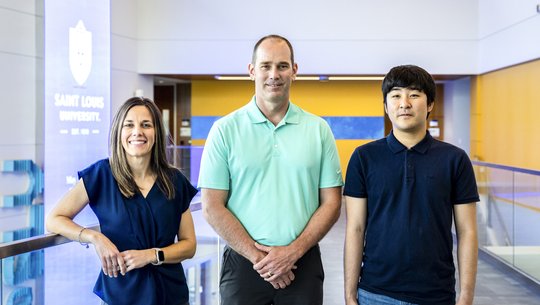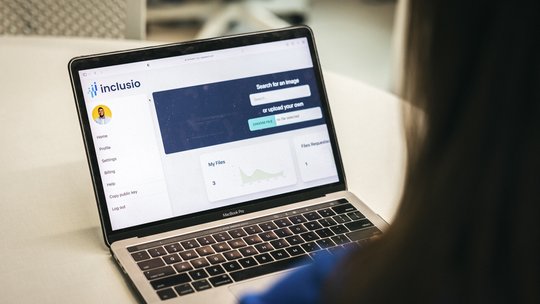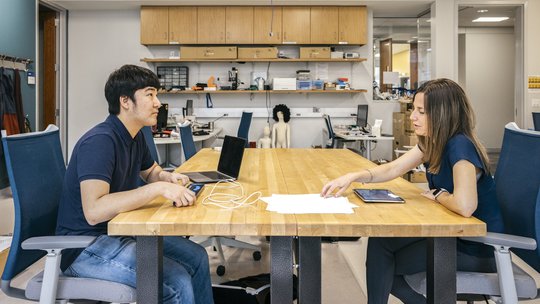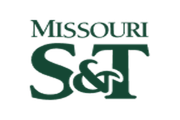
Educator and engineer Jenna Gorlewicz was studying medical robotics at Vanderbilt University when she met a sixth grader who would change the course of her career. Kira, a student in a school where Gorlewicz was volunteering, said, “You’re an engineer? That’s so cool!” Then Kira said, “I’ll never be one,” citing her blindness as a key barrier.
Disheartened by Kira’s statement, Gorlewicz proceeded to learn more about the barriers that individuals with blindness and low vision face. She would come to learn that poor accessibility standards historically have affected these students, particularly in the STEM fields, where textbooks often contain dense graphical information and diagrams. This content has neither been effectively nor efficiently translated for this group of learners.
Moreover, these inequities remain pronounced as students enter adulthood, and they have stark implications for their quality of life. As of 2023, roughly 45% of blind and low-vision people of working age participate in the labor force, as compared to 75% of the non-visually impaired, non-blind population. Gorlewicz refocused her dissertation on accessible graphics — e.g., charts, diagrams, maps and graphic organizers — just as touchscreens hit the market.
Gorlewicz is now the associate dean of research and innovation at Saint Louis University, where she also serves as an associate professor of aerospace and mechanical engineering. This January, she and a team of long-standing partners in the blind and low-vision community received a highly competitive $5 million Convergence Accelerator Phase 2 award from the U.S. National Science Foundation to further develop a groundbreaking technology called Inclusio. It seeks to address the concern expressed by Kira years prior by providing easy and equitable access to visual information, regardless of vision level or disability status.
Pioneering equal access to visual information with interoperability
Inclusio is a suite of digital tools with three main components: a searchable content repository; automated, AI-powered tools for retrofitting visual information into accessible formats; and accessible authoring tools to build such inclusive content from scratch. As a software solution, it is designed to break down silos in what is currently a highly fragmented accessibility landscape.
It will do this by serving a variety of end users, including publishers, teachers and individuals with blindness and low vision. And it will operate on users’ existing devices, allowing them to choose their preferred format by generating content alternately reliant on sound, touch, sight or a combination thereof.
“Imagine a bar chart on your touchscreen. If you move your fingers around on the chart, you can feel vibrations and hear text labels,” Gorlewicz says. “It maps your fingers’ exploration of the information and conveys it through vibration and sound, in addition to a visual display.”

This ability to display information in multiple formats — and to do so on demand, based on user preference — is known as interoperability. Inclusio is pioneering interoperability in accessibility, with the potential to transform how people engage with information. The same user might prefer braille in certain situations, touch technology in others and spoken description in yet others, according to Seyoon Choi, a product design and evaluation specialist for Inclusio who is slated to graduate from SLU in May 2024 with a master’s degree in social work, and who is blind.
“I’m a graduate student still, so I’ve been through the thick and thin of it,” he says. “The biggest obstacle is being able to access visual information when you need it, in a format which you prefer.”
Indeed, centralizing and improving access to graphic information represents a huge leap forward for the blind and limited vision community. At present, it often takes half a year or more to create accessible formats of textbooks, as well as highly trained specialists and expensive equipment costing thousands of dollars.

Kevin Hollinger knows this problem all too well. An Inclusio consultant and 25-year veteran teacher of blind and low-vision individuals in the Francis Howell School District, Hollinger seeks to achieve access that meets three criteria: robust, timely and equitable. “School districts should not have to suffer a financial windfall because materials are inaccessible,” he says. “Inclusio is going to help bridge that gap.”
The involvement of Choi, Hollinger and over a dozen other partners nationwide from across education, the publishing industry and the blind and low-vision community demonstrates Inclusio’s roots in human-centered, user-inspired design.
“Inclusion really starts from the ground up,” Choi says. “What excites me the most about Inclusio is the utmost potential created through such an extensive design, development, and testing phase. We (users who are blind or have low vision) are fully included in the process.”
STLMade is a movement within the St. Louis metro that shines a light on the amazing things our innovative, tenacious, big-hearted people are doing. It’s supported by a region-wide collaboration of residents, local leaders, institutions, organizations, businesses and nonprofits helping to tell our story — that St. Louis is a place where you can start up, stand out and stay.



